|

Yi-House Art Hotel Elevator
Beijing
May 2011
|
|
|
Welcome to Hung Liu Studio Newsletter #2. It covers the artist's activities in China for the month of May. While there, she had exhibitions in Beijing, Shanghai, and was included in the Hong Kong Art Fair. Two new magazine features are also highlighted. We hope you enjoy this peek into the Chinese art world.
|
|
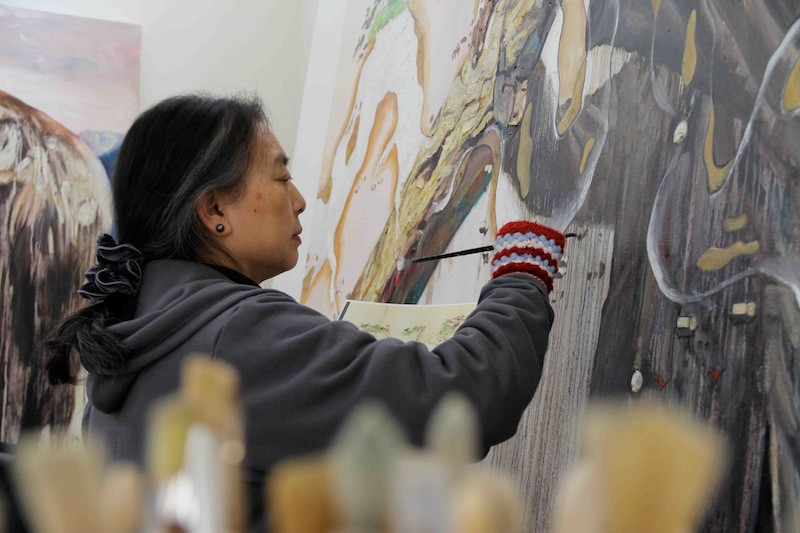 |
|
Exhibitions in China
First Spring Thunder
Alexander Ochs Gallery, Beijing
May 29 - July 17
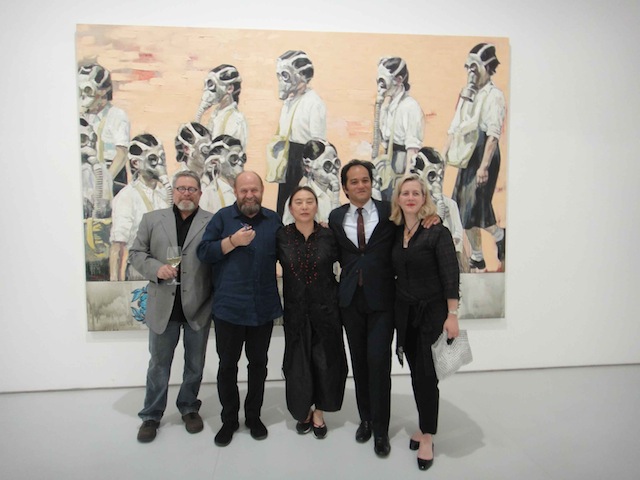 | |
Jeff Kelley, Alexander Ochs, Hung Liu,
Rene & Marnie De Guzman
|
Hung Liu's new paintings at Alexander Ochs Gallery in Beijing, collectively titled "First Spring Thunder," revolve around the idea of a struggle to awaken in a dream, in memory, in the mind. Traditionally, the first spring thunder is a two-week season in China during which the insects awaken from their winter dormancy. The world is asleep and then it begins to wake up. In Liu's paintings, however, that waking is not always innocent - it is slow and fitful, as if caught between life and a dream of life. Based on imagery from a combination of Chinese historical photographs and traditional paintings, these works suggest that the difference between antiquity and modernity, utopia and terror, stillness and death, and silence and thunder is very thin, like a veil.
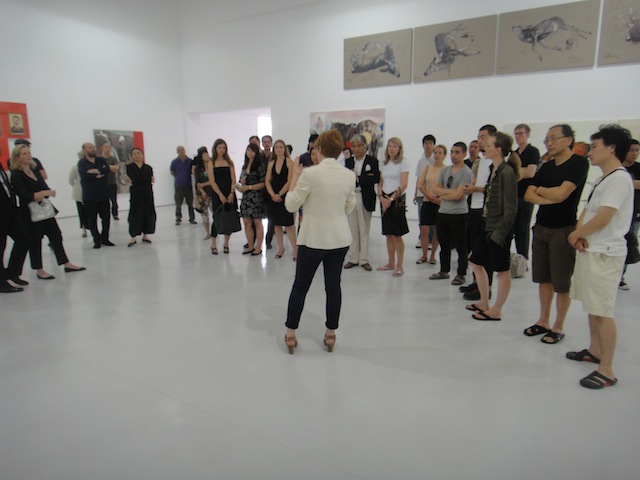 | |
Karen Smith introducing the artist
|
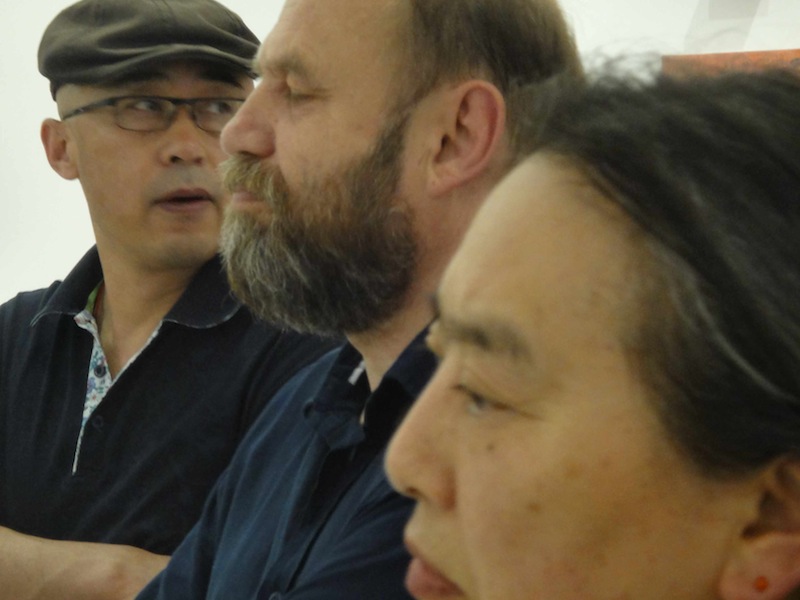 | |
Yang Shaobin, Alexander Ochs, Hung Liu
|
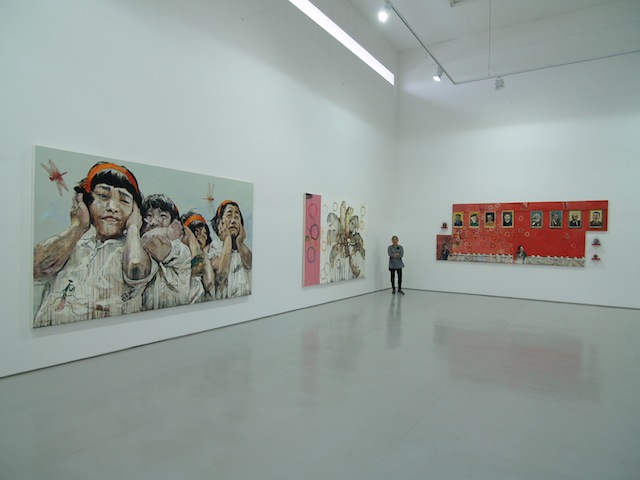 | |
First Spring Thunder @ Alexander Ochs
|
School girls might be covering their ears from the rumbling of thunder - or from the guns of war. Flying insects are dancing all around them - or attacking like military aircraft. A flock of white cranes may be exulting in flight - or scattering at the sound of danger. A serene landscape invokes an ancient paradise - or a frozen fantasy. A dead bird can be seen as a still life - or as a sparrow (one of millions) that fell from the Chinese sky during Mao's infamous "Kill the Sparrows" movement of 1957. Given this double (and perhaps more sinister) reading, the images of insects, birds, and deer in Liu's paintings serve as warnings of some impending catastrophe, or echoes of catastrophes past. Many of them are dead. Nothing is quite as it appears.

A helmsman maneuvers his boat along the Yangtze River, but seems blind, steering only by aid of a mental map from an ancient time. Even in the most beautiful paintings, people can't hear, can't see, can't breathe, are mute, or are lost in a stale dream. Perhaps by covering their ears or wearing gas masks, they are trying to protect their own senses from some toxic exposure. In Liu's new exhibition, the idea of first spring thunder rumbles like history through the Chinese mind.
 | |
Hung Liu & Fang Lijun at the opening in Beijing
|
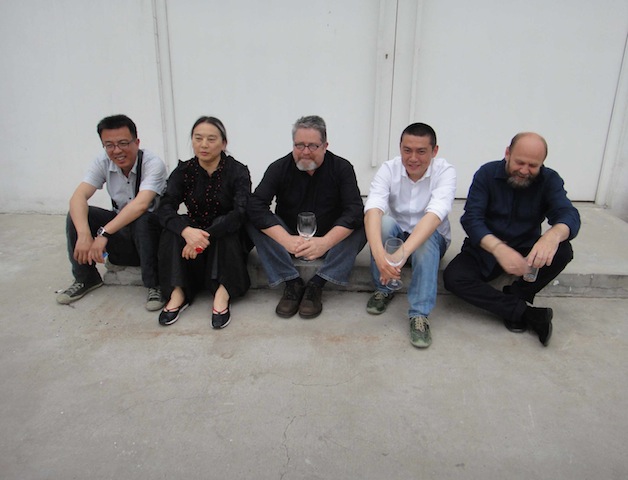 | |
Liu Xiaodong, Hung Liu, Jeff Kelley, Li Songsong, Alexander Ochs
|
|
|
Concession
Elizabeth De Brabant Gallery, Shanghai
May 20 - July 22, 2011
 | |
Elizabeth De Brabant & Hung Liu
|
With a selection of paintings and Za Zhong (ZZ) mixed media resin works, Concession taps into the history of allure, prostitution, and commerce in Shanghai. Below are excerpts of an interview the artist did with a local magazine:
Q: 这次在博雅珊举办的个展为什么取名为妥协呢?
A: First of all, the title "Concession" (or in Chinese 祝捷zhujie) is about the history of the city of Shanghai--a city of international settlement and concession. This title reflects a certain period of modern Chinese history. The Elisabeth de Brabant Art Center is located in the French Concession. Secondly, I think even in art you make "concessions" to different things. Like looking back at the city's history, and in the history of China in different times, regions and periods, there were always temporal, spacial and emotional concessions being made. The subjects of my art are primarily women, and particularly women from the feudal society. I think of women as constantly making concessions. This idea ties in with the history of China, and especially the history of Shanghai.
Q: 您的作品人物形象都是女性?是想要传达怎样的情绪和思想呢?
A: Yes, most of my subjects are female. I think first of all, I am a woman. So it's natural. Looking back on the history of women in the world, especially the history of Chinese women, there is a history of suppression, culturally and politically. In Chinese history, there have been two kinds of women. The first kind is the woman as laborer, worker--劳动的妇女. And if you extend that, the woman as soldier during the war, as fighters. Women in this first category are in charge of their lives. They are working with their male counterpart shoulder to shoulder. The second kind is the woman as subject to a male need, like the prostitute.
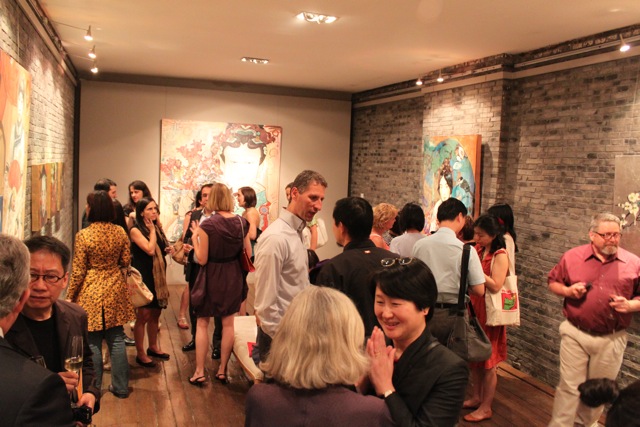 | |
Elizabeth De Brabant Gallery
|
These are courtesans subject to the male gaze, in front of the camera. Even in imperial court, they existed: decorative kind of pretty things. Women "for sale". I am interested in the contrast between these two kinds of women; strong, independent women, and the women who have completely lost their freedom, family, and identity. So, in my work, I want to restore dignity to the second kind. Return the male gaze in the more aggressive, strong, dignified way. Give them back the ability to be human again. In the show, I do have two sister pieces: one is Travelogue I 行旅 I, another is Checkmate将军. These two works have men in them: So, I do not paint only women.
Q: 在您创作中一般如何寻求灵感?给我们讲一些您的创作中的小故事吧。
A: I lived the first half of my life in China, lived through the revolution, was sent to the countryside. During the Cultural Revolution lots of books and family photos were burned, destroyed. In order to protect ourselves, we burned family photographs. When I saw in the U.S. old photographs of Chinese, I felt really overwhelmed. Like "oh my God, these images survived." Back then, it wasn't the digital age. One photograph really was worth a thousand words. Also, the moments captured by cameras from that time were black and white. So when I found one image that strongly provoked me, I started to think: what if I made it into a big painting. Because as a photo, no one pays attention. I wanted to make these images them 6 feet tall, to discover for myself what was underneath the layers. It's like excavation. Of course, I could never discover the whole truth--the whole story.
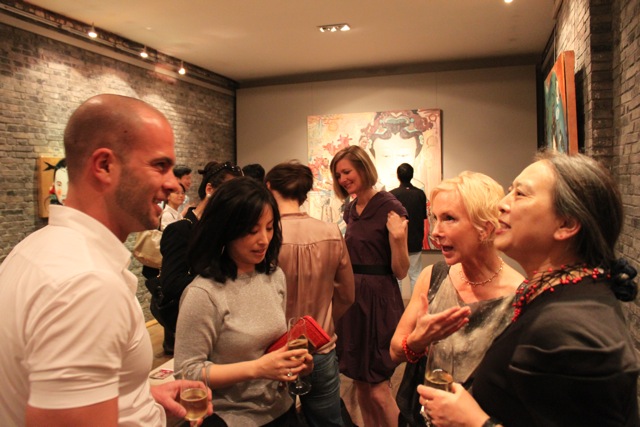 | |
Opening of "Concession" in Shanghai
|
But it is a great process. And in the end, more questions are raised than answered. In terms of 灵感--you need to discover, to excavate. To peel off the layers and try to find out what was there that got lost. There is always something missing. Also, as an artist, I have to make up colors. You can never get to the original. As one example: In my painting On Queue辫子功--Qing dynasty men had to wear the queue (braid). In this painting, the subject is studying geometry, and using his braid as a compass. The original photograph captured a very simple moment. The painting is almost like traditional Chinese meets Western contemporary--it represents an almost primitive, very conservative way of living. Each painting has its own story. How I connect to it personally differs from painting to painting. I am inspired by a certain image, then I build upon that.
Q: 您的艺术手法很特别,为什么会想要根据老照片而进行创作呢?是不是跟您的成长经历有关?
A: It does have a lot to do with my personal experience. I was trained in China in artistic ideology beginning from college and going to grad school. My initial education came directly from Soviet Union 现实注意 zhuji, or Socialist Political Agenda. The art style at that time was realism. Illustration-like. So, using old photographs was seen as kind of cheating. In the past, I have used models, landscapes--but I think that is not real freedom. Real freedom is allowing yourself to open up no matter what your inspiration. Could be a tree. You paint a realistic tree, it doesn't mean much.
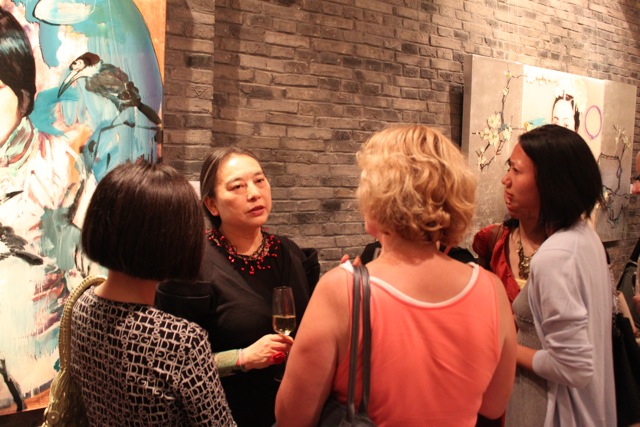 | |
Opening reception of "Concession" in Shanghai
|
I want a portrait of a woman--maybe not even just a pretty face. Something beyond that. That's important for me--to free myself from this Socialist Realism. Because to me, Socialist Realism is more like Socialist Surrealism. When I was in the countryside on a rainy day our pants are dirty no one has a huge smile on their face like on the posters. In the war, there was no one posing heroically. That kind of pseudo-realism is really Surrealism. It's a fantasy. It's romanticism. I'm inspired by photography, but I see it more closer to reality. Seeing it this way, it's not about copying. It's not about imitating nature or the image. It's about re-creating. And creating. Giving new life to old photographs. Turning old photographs into new paintings.
|
|
Two New Magazines 1. American Art: Smithsonian American Art Museum
an interview with Hung Liu by Joann Moser
|

2. Leap: The International Art Magazine of Contemporary China
a visual history and commentary by Phil Tinari
|
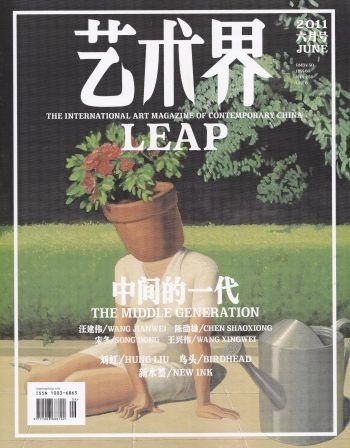
Two Recent Books
1. Contemporary Chinese Art:
Primary Documents
edited by Wu Hung
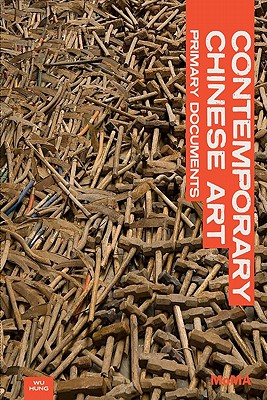
This MOMA publication brings together, translates, and contextualizes primary documents that are pertinent to a deeper understanding of recent artistic practice in China, but which were not previously available in the English language. Hung Liu is featured in the text.
2. Hung Liu: Great Granary
(Tai Cang 太倉)
Wu Hung
essays by Xu Bing, Sui Jianguo, Yu Hong, Liu Xiaodong, Li Songsong, & Wei Lin
Xin Beijing Art Gallery, Beijing
Timezone 8, Beijing

In May 2008 an exhibition of my work was presented in Beijing at the Xin (New) Beijing Art Gallery titled, Tai Cang 太倉. The book is a document of that exhibition and the conversations that happened around it.
The gallery was located in an over 600-year old imperial granary and became an important part of the exhibition. Curated by Wu Hung (who also contributed an essay to the book as well as an interview between he and I) the exhibition was realized in two parts.
The first part was a survey of my paintings made from the late 1980s to 2008. A selection of the paintings related to subjects dealing with hunger, starvation or food accumulation.
The second part of the exhibition was a site-specific installation and had two major components to it. The first was a reinterpretation of a mural I once painted in the dinning hall at the Central Academy of Fine Art in Beijing (CAFA). The mural was an ode to a recent excavation of ancient bronze bells and to the possibility of harmony as freedom. The former CAFA property was sold and the mural, along with the building, were destroyed. In recreating the mural, the drawings for the original were digitally printed on wooden panels (by Don Farnsworth of Magnolia Editions), and on top of that history I began to paint new elements. The resulting mural was a kind of remembering of the destroyed original. I was collaborating with my younger self.
The installation also involved a selection of antique dou斗 (a traditional grain container and unit of measure). Each one contained grain from a different region of China, which is composed of 34 provinces and special administrative or autonomous regions. The 34 dou were arranged to form a map of China on the gallery floor.
In addition to this project I invited CAFA alumni to write about their memories and experiences of the mural from their days at the Academy. Many generations of young artists at CAFA ate, conversed, played music, and grew up in front of the mural, which, because it was not Socialist Realist, seemed to signify something new - a background for creative thinking and excitement. In fact, the first Chinese rock and roll concert was held in front of the mural. Artists such as Xu Bing, Liu Xiaodong, Yu Hong, Sui Jianguo, and Li Songsong all contributed writing about the mural to this catalog.
Hung Liu
Oakland, California
Books available at Timezone 8 and Amazon.com |
|
Thank You!
Hung Liu Studio |
|
|
|